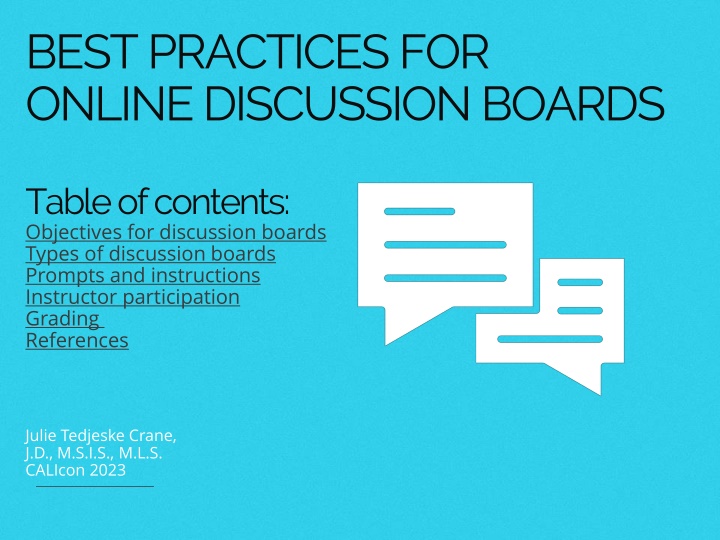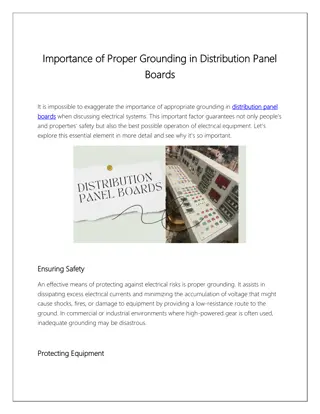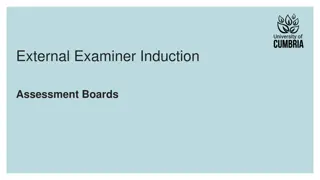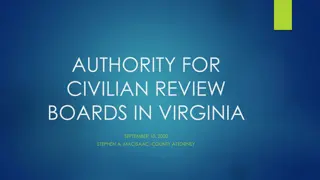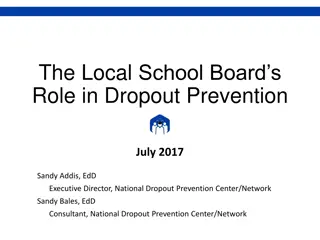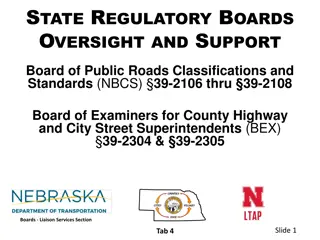Best Practices for Online Discussion Boards
In this guide by Julie Tedjeske Crane, explore objectives, types, prompts, and instructions for effective online discussion boards. Learn about engagement strategies, instructor involvement, grading, and more to enhance student interaction and learning outcomes.
Download Presentation

Please find below an Image/Link to download the presentation.
The content on the website is provided AS IS for your information and personal use only. It may not be sold, licensed, or shared on other websites without obtaining consent from the author.If you encounter any issues during the download, it is possible that the publisher has removed the file from their server.
You are allowed to download the files provided on this website for personal or commercial use, subject to the condition that they are used lawfully. All files are the property of their respective owners.
The content on the website is provided AS IS for your information and personal use only. It may not be sold, licensed, or shared on other websites without obtaining consent from the author.
E N D
Presentation Transcript
BEST PRACTICES FOR ONLINEDISCUSSION BOARDS Tableof contents: Objectives for discussion boards Types of discussion boards Prompts and instructions Instructor participation Grading References Julie Tedjeske Crane, J.D., M.S.I.S., M.L.S. CALIcon 2023
Objectives for Discussion Boards
Objectives for discussion boards Introductions This is the typical tell me something about yourself prompt. It allows the students to learn more about each other and for the professor to become familiar with the students. Initial Engagement This is where students engage with the materials before class. Online discussion board posts can serve as a jumping-off point for classroom discussion. Having a pre-class discussion board helps ensure that the students review the materials before class. Application This means having students apply what they learned in class to a given situation. Often, it makes sense to give students a somewhat open-ended problem to work on and have them post their answers. Students can compare what they did with their peers submissions. Extension This is similar to application, only it requires taking what the student learned and applying it to a new area or integrating what they learned in one context to another context. Source: Jessica Erickson, Preparing for Fall Teaching Discussion Boards in Physically Distanced, Hybrid, and Remote Courses, PrawfsBlawg (July 21, 2020) | 3
Types of Discussion Boards
Types of discussion boards Ice Breakers Examples These are introductions. You can ask for general background information or a fun fact about the student. Sometimes it makes sense for students to submit a video rather than text. That makes it easier to learn students names. Students share examples guided by the prompt. The PrawfsBlawg post in the references gives the example of having each student name a discovery tool that might be used in a given situation. Students cannot select something another student already mentioned. Jigsaw Student Led Each member of the group becomes an expert on a different aspect of a larger topic. Then the group comes together to organize each piece of the puzzle into a coherent whole. You can assign students to lead a discussion, including creating the prompt or question or by summarizing the responses at the end. Assigned Role Evaluative Each student has an assigned role, such as organizer, devil s advocate, etc. Or you can assign roles like plaintiff s attorney or defense attorney. Students post their work on a project to the discussion board and other students provide suggestions and feedback. | 5
Prompts and Instructions
What should you use for a prompt? How should students respond? Many sources recommend using 3CQ or a variation for student responses. This means that every student response should have Prompts can be challenging to draft. You are looking for a sweet spot between being too open- ended and too narrow. A complement; The most important thing to consider in drafting a prompt is that you need to facilitate an online conversation. Anything with a clear answer is unlikely to be a good prompt. On the other hand, asking students to generally respond to the readings for the week is too broad. A comment; A connection; and A question. I usually provide a broad prompt with a series of sub-questions for students to address. Many students will structure their post by cutting and pasting the prompts to make them headings for their response. The item from MIT on the reference list includes an example of a discussion prompt with instructions. I sometimes give students a list of sub-questions relating to the main prompt and tell them that the list of sub-questions is illustrative of the types of things they might discuss. | 7
What should you include in the instructions? This is a non-exhaustive list of things that you might want to include in your instructions: 1. Are the word counts global, or are there separate word counts for the original post and any replies? 2. Number and type of required replies, if any. Are there any requirements for the format of the reply? (For example, must replies follow a 3CQ format?) 3. Is it a post-first forum? (That means the student must post before they can see any other posts.) 4. Will you be grading based on grammar, citation formatting, etc.? Do students need to do any outside reading or research? 5. Are there separate due dates for the original post and any replies? What are the penalties for late work? | 8
Instructor Participation
How should you participate and how much should you participate? I try to do a responsive post to every post in an "introductions" discussion board. But otherwise, I post sparingly. I will often leave private comments in the LMS for the individual student as I am grading, in part, so they know that I am reading the posts. You need to signal to students that you are aware of what is happening on the discussion boards. There is no one correct approach. The general advice is that instructors should participate in discussion boards. However, if you are too present, you may stifle the conversation. Often, I hesitate to share an insight because doing so may rob a student of the opportunity to contribute something similar to what I was going to say. Here is an example from Johns Hopkins of how to explain the instructor's role: "As stated above in the grading rubric, I will be providing feedback on the quality of your response to the original discussion question. I will not be responding to each post in the discussion forum but please know that I am reading and keeping an eye for the direction of the discussion is taking. If needed, I made provide some expertise to guide the discussion." If incorrect information is being shared, you might want to offer a clarification. And if things have gotten too personal or inappropriate, you can step in to get things back on track. Some instructors are sure to respond to each post. Others will try to respond to "orphan" posts that don't have other replies. And still others summarize the conversation. | 10
How should you grade discussion boards? You can grade discussion boards based on both the quantity and quality of posts.Or you might want to use completion grading. Grading discussion boards can be challenging, especially when students are asked to share their personal opinions or subjective experiences. I tend to use completion grading for discussions, meaning that timely, good-faith submissions receive full credit. The item from Johns Hopkins on the reference list includes an example of a rubric for grading a discussion board. | 12
References Jillian Rubman, 4 Tips to Design an Engaging Discussion in Canvas, MIT Sloan Teaching & Learning Technologies (January 7, 2022). Jessica Erickson, Preparing for Fall Teaching Discussion Boards in Physically Distanced, Hybrid, and Remote Courses, PrawfsBlawg (July 21, 2020). Editorial Team, Wharton Interactive, Running a Discussion Board, Learning Insights (April 2020). Mark Lieberman, Discussion Boards: Valuable? Overused? Discuss, Inside Higher Education (March 26, 2019). Taryn Marks & Rachel Purcell, Enhancing the Online Learning Environment: Strategies for Increasing Student Engagement, AALL Spectrum 21 (March-April 2018). Johns Hopkins, Discussions in Online Courses: Best Practices and Expectations. | 14
